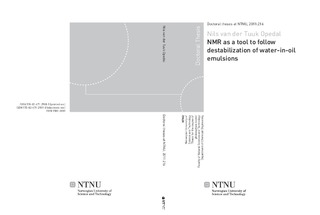| dc.contributor.author | Opedal, Nils van der Tuuk | nb_NO |
| dc.date.accessioned | 2014-12-19T13:23:33Z | |
| dc.date.available | 2014-12-19T13:23:33Z | |
| dc.date.created | 2012-01-20 | nb_NO |
| dc.date.issued | 2011 | nb_NO |
| dc.identifier | 505962 | nb_NO |
| dc.identifier.isbn | 978-82-471-2988-3 (printed ver.) | nb_NO |
| dc.identifier.isbn | 978-82-471-2989-0 (electronic ver.) | nb_NO |
| dc.identifier.uri | http://hdl.handle.net/11250/248283 | |
| dc.description.abstract | Due to depletion of conventional sources and increasing demand for crude oil, the last years have shown a shift towards the exploitation of heavier and technologically more difficult feedstocks. This shift of focus means that the entire oil industry needs to update its fundamental and practical understanding of the technology, including the separation process.
To be able to more carefully study crude oil emulsion stability, one should be able to characterize the emulsion system in higher detail. By using Nuclear Magnetic Resonance (NMR) several advantages are apparent. One is able to study the entire sample, even the inside of a dark liquid. Concentrated samples can be studied and the apparatus is highly versatile. The droplet size distribution, position dependent size profiles and position dependent brine profiles can be obtained.
With the new and validated NMR methods one can study in more detail how the various stabilizing parameters and destabilizing actions affect the behavior and the overall separation of crude oil emulsions. The method to measure the droplet size distribution can give information on the emulsification process and help predict the rheological and separation characteristics of an emulsion. Knowledge on the mean, width and shape of a droplet size distribution are important to be able to fully understand the behavior.
By measuring the stability of an emulsion, either by the acquisition of iso-volumetric or isometric curves, one can monitor both the oil quality and the water recovery rate. This can be helpful in studying the demulsification process where a demulsifier can be selected on the basis of how fast the water recovers or how much water there is left in the oil phase. The methods can also be used in connection with theoretical modeling of emulsion stability. The measurements of droplet growth rates, thickness of concentrated emulsion layers and the sedimentation and coalescence rates can give information that can be very valuable to understand the separation process. | nb_NO |
| dc.language | eng | nb_NO |
| dc.publisher | Norges teknisk-naturvitenskapelige universitet, Fakultet for naturvitenskap og teknologi, Institutt for kjemisk prosessteknologi | nb_NO |
| dc.relation.ispartofseries | Doktoravhandlinger ved NTNU, 1503-8181; 2011:216 | nb_NO |
| dc.relation.haspart | Opedal, N; Sørland, G; Sjöblom, J.. Methods for Droplet Size Distribution Determination of Water-inoil Emulsions using Low-Field NMR. Diffusion Fundamentals. (ISSN 1862-4138). 9(7): 1-29, 2009. | nb_NO |
| dc.relation.haspart | Opedal, Nils van der Tuuk; Sorland, Geir; Sjoblom, Johan. Emulsion Stability Studied by Nuclear Magnetic Resonance (NMR). Energy & Fuels. (ISSN 0887-0624). 24: 3628-3633, 2010. <a href='http://dx.doi.org/10.1021/ef100268x'>10.1021/ef100268x</a>. | nb_NO |
| dc.relation.haspart | Opedal, Nils van der Tuuk; Kralova, Iva; Lesaint, Caterina; Sjoblom, Johan. Enhanced Sedimentation and Coalescence by Chemicals on Real Crude Oil Systems. Energy & Fuels. (ISSN 0887-0624). 25(12): 5718-5728, 2011. <a href='http://dx.doi.org/10.1021/ef201270f'>10.1021/ef201270f</a>. | nb_NO |
| dc.relation.haspart | Opedal, Nils van der Tuuk; Sjöblom, Johan. Emulsion stability of a SAGD produced extra heavy crude oil.. . | nb_NO |
| dc.title | NMR as a tool to follow destabilization of water-in-oil emulsions | nb_NO |
| dc.type | Doctoral thesis | nb_NO |
| dc.contributor.department | Norges teknisk-naturvitenskapelige universitet, Fakultet for naturvitenskap og teknologi, Institutt for kjemisk prosessteknologi | nb_NO |
| dc.description.degree | PhD i kjemisk prosessteknologi | nb_NO |
| dc.description.degree | PhD in Chemical Engineering | en_GB |

